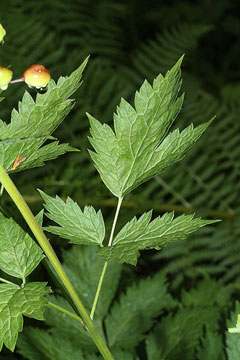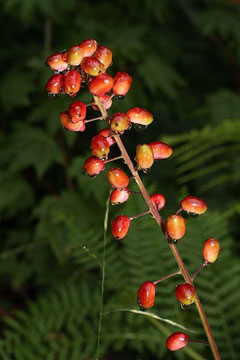 |
|
http://commons.wikimedia.org/wiki/User:Wsiegmund |
 |
| http://commons.wikimedia.org/wiki/User:Wsiegmund |
Translate this page:
Summary
Physical Characteristics

 Actaea rubra is a PERENNIAL growing to 0.5 m (1ft 8in) by 0.3 m (1ft).
Actaea rubra is a PERENNIAL growing to 0.5 m (1ft 8in) by 0.3 m (1ft).
See above for USDA hardiness. It is hardy to UK zone 3. It is in flower from June to July, and the seeds ripen from July to August. The species is hermaphrodite (has both male and female organs).
Suitable for: light (sandy), medium (loamy) and heavy (clay) soils. Suitable pH: mildly acid, neutral and basic (mildly alkaline) soils. It can grow in full shade (deep woodland) or semi-shade (light woodland). It prefers moist soil.
UK Hardiness Map
US Hardiness Map
Synonyms
A. arguta. Nutt.
Plant Habitats
Woodland Garden Dappled Shade; not Deep Shade;
Edible Uses
References More on Edible Uses
Medicinal Uses
Plants For A Future can not take any responsibility for any adverse effects from the use of plants. Always seek advice from a professional before using a plant medicinally.
Analgesic Antirheumatic Appetizer Emetic Galactogogue Purgative Rubefacient
The whole plant, but especially the root, is analgesic, antirheumatic, galactogogue and rubefacient[172, 257]. The plant was often used medicinally by North American Indian tribes, though modern users should be aware of the plants potential toxicity. A tea made from the root is used as an appetizer, in the treatment of stomach pains, coughs, colds, menstrual irregularities, post partum pains, to increase milk flow and as a purgative after childbirth[222, 257]. Great caution should be employed if using this plant internally, the rootstock is a violent purgative, irritant and emetic[212].
References More on Medicinal Uses
The Bookshop: Edible Plant Books
Our Latest books on Perennial Plants For Food Forests and Permaculture Gardens in paperback or digital formats.

Edible Tropical Plants
Food Forest Plants for Hotter Conditions: 250+ Plants For Tropical Food Forests & Permaculture Gardens.
More

Edible Temperate Plants
Plants for Your Food Forest: 500 Plants for Temperate Food Forests & Permaculture Gardens.
More

More Books
PFAF have eight books available in paperback and digital formats. Browse the shop for more information.
Shop Now
Other Uses
References More on Other Uses
Cultivation details
Tolerates most conditions[233], but prefers a humus-rich moist soil in light shade[200, 233] doing well amongst shrubs and in light woods[1]. Also succeeds in denser shade[187]. Plants are hardy to at least -20°c[187]. A very ornamental plant[1]. Actaea rubra is part of a circumboreal complex and is very similar to the black-fruited European species A . spicata (L.) with which it is sometimes considered conspecific[270]. The western North American plants of A . rubra have been called A . arguta and were distinguished on the basis of their smaller berries, more pubescent leaves, and narrow, more dissected leaflets. Those distinctions, however, are weak; specimens from the West often have fruits and leaves similar to those of plants from the East[270]. A greedy plant, inhibiting the growth of nearby plants, especially legumes[54].
References Carbon Farming Information and Carbon Sequestration Information
Temperature Converter
Type a value in the Celsius field to convert the value to Fahrenheit:
Fahrenheit:
The PFAF Bookshop
Plants For A Future have a number of books available in paperback and digital form. Book titles include Edible Plants, Edible Perennials, Edible Trees,Edible Shrubs, Woodland Gardening, and Temperate Food Forest Plants. Our new book is Food Forest Plants For Hotter Conditions (Tropical and Sub-Tropical).
Shop Now
Plant Propagation
Seed - best sown as soon as it is ripe in the autumn in a cold frame or outdoors in a moist shaded seedbed[200]. The seed has a limited viability[200], it can also be sown in spring in a cold frame but germination rates may be poor. When they are large enough to handle, prick the seedlings out into individual pots and plant them out into their permanent positions in late spring or early summer of the following year. Division in March or October.
Other Names
If available other names are mentioned here
Native Range
TEMPERATE ASIA: Russian Federation-Western Siberia (Western Siberia), Russian Federation-Eastern Siberia (Eastern Siberia), Russian Federation-Far East (Far East), China (Heilongjiang Sheng, Hebei Sheng, Jilin Sheng, Liaoning Sheng, Shanxi Sheng, Nei Mongol Zizhiqu), Japan (Hokkaidô, Honshu) NORTHERN AMERICA: Canada (Northwest Territories, Yukon, Québec, Nova Scotia, Ontario, Prince Edward Island, New Brunswick, Newfoundland and Labrador, Saskatchewan, Alberta, Manitoba, British Columbia), United States (Alaska, Connecticut, Indiana (north), Maine, Massachusetts, Michigan, New Hampshire, New Jersey (north), New York, Ohio (north), Pennsylvania, Rhode Island, Vermont, Illinois (north), Iowa, Minnesota, Nebraska (e. & n.w.), North Dakota, South Dakota (s.e. & w.), Wisconsin, Colorado, Idaho, Montana, Oregon, Washington, Wyoming, New Mexico, Arizona, California, Nevada, Utah) EUROPE: Finland, Norway, Sweden, Russian Federation-European part (European part (north))
Weed Potential
Right plant wrong place. We are currently updating this section.
Please note that a plant may be invasive in one area but may not in your area so it's worth checking.
Conservation Status
IUCN Red List of Threatened Plants Status :

Growth: S = slow M = medium F = fast. Soil: L = light (sandy) M = medium H = heavy (clay). pH: A = acid N = neutral B = basic (alkaline). Shade: F = full shade S = semi-shade N = no shade. Moisture: D = dry M = Moist We = wet Wa = water.
Now available:
Food Forest Plants for Mediterranean Conditions
350+ Perennial Plants For Mediterranean and Drier Food Forests and Permaculture Gardens.
[Paperback and eBook]
This is the third in Plants For A Future's series of plant guides for food forests tailored to
specific climate zones. Following volumes on temperate and tropical ecosystems, this book focuses
on species suited to Mediterranean conditions—regions with hot, dry summers and cool, wet winters,
often facing the added challenge of climate change.
Read More
Expert comment
Author
(Aiton.)Willd.
Botanical References
200270
Links / References
For a list of references used on this page please go here
Readers comment